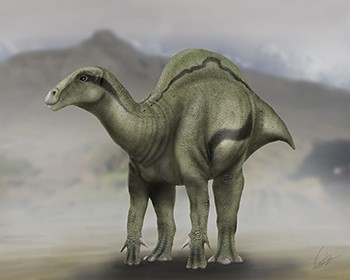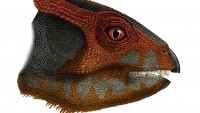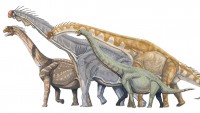New Dinosaur Discovered With Strange 'Sail' On Its Back
| Ana Verayo | | Dec 17, 2015 06:20 AM EST |
(Photo : UNED) Reconstruction of the appearance of 'Morelladon beltrani'
A team of scientists discovered never before seen fossils of a new species of dinosaur located in Morella, Spain. This dinosaur is also unique, as it boasts a sail on its back, where scientists now dub it as Morelladon beltrani, that existed some 125 million years ago.
Researchers from the National Distance Education University and the Autonomous University of Madrid estimate that this ancient creature measured about six meters long and 2.5 meters high, weighing around two tons.
Like Us on Facebook
This new dinosaur apparently belongs to the group known as ornithopods where they are considered to be herbivorous, or plant eaters which also holds clues about the massive morphological diversity among their species. According to co-author of the study, Fernando Escaso from the National Distance Education University, some members of this group are classified as bipedal however this Morella dinosaur walked on four legs.
This dinosaur that was uncovered in Morella also used its hind legs to make short forays but other than that, it spends most of its time walking on four legs. The fossilized remains also originate from an unknown species discovered back in 2013, after analysis.
The Morelladon beltrani is also named after Vicente Beltran, the owner of a quarry in southern Barcelona where the fossils were uncovered. It is a medium sized ornithopod that is also has similarities with another European dinosaur known as Mantellisaurus atherfieldensis.
But above all, this new dinosaur also possesses a strange feature in the dorsal side of its vertebrae consisting of very long neural spines, according to researchers.
The spines are thought to support some sort of "sail" that runs across the creature's back that can help regulate the dinosaur's body temperature and even store fat in them, to sustain them during long periods of time when food is scarce, similar to camels and bisons of today.
Scientists also believe that this sail-type structure can also indicate the individual members of the species or even determine males and females of the species. This new study is published in the journal, PloS ONE.
Tagsdinosaur with sail on back, morella dinosaur spain, morella spain, Dinosaurs, new dinosaur species, ornithopods, Morelladon beltrani
©2015 Chinatopix All rights reserved. Do not reproduce without permission
EDITOR'S PICKS
-

Did the Trump administration just announce plans for a trade war with ‘hostile’ China and Russia?
-

US Senate passes Taiwan travel bill slammed by China
-

As Yan Sihong’s family grieves, here are other Chinese students who went missing abroad. Some have never been found
-

Beijing blasts Western critics who ‘smear China’ with the term sharp power
-

China Envoy Seeks to Defuse Tensions With U.S. as a Trade War Brews
-

Singapore's Deputy PM Provides Bitcoin Vote of Confidence Amid China's Blanket Bans
-

China warns investors over risks in overseas virtual currency trading
-

Chinese government most trustworthy: survey
-

Kashima Antlers On Course For Back-To-Back Titles
MOST POPULAR
LATEST NEWS
Zhou Yongkang: China's Former Security Chief Sentenced to Life in Prison

China's former Chief of the Ministry of Public Security, Zhou Yongkang, has been given a life sentence after he was found guilty of abusing his office, bribery and deliberately ... Full Article
TRENDING STORY

China Pork Prices Expected to Stabilize As The Supplies Recover

Elephone P9000 Smartphone is now on Sale on Amazon India

There's a Big Chance Cliffhangers Won't Still Be Resolved When Grey's Anatomy Season 13 Returns

Supreme Court Ruled on Samsung vs Apple Dispute for Patent Infringement

Microsoft Surface Pro 5 Rumors and Release Date: What is the Latest?













